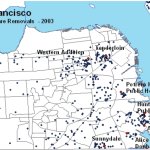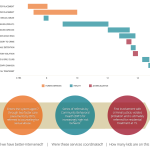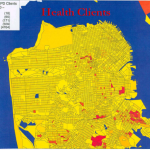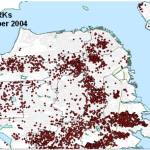Getting Big Data to the Good Guys: SF Brings Business Intelligence …

By Stephen Goldsmith & Christopher Kingsley.
Chances are very good that the last call you received from a congressional campaign was personal. A volunteer chose your seven-digit number, out of thousands in the ward, because an algorithm comparing dozens of data points on when you registered, how you’ve voted, and what kind of truck you drive suggested that you were persuadable. The pitch was calibrated according to the magazines to which you subscribe and your credit history. The result of the call was recorded by the campaign, to be considered alongside the outcomes of other calls being made concurrently to people that – the data suggested – were an awful lot like you, in order to better persuade the next voter. This is what integrated data looks like on the campaign trail: dozens of linked datasets, sophisticated modeling, message testing, and a significant edge over the retail politics of yesteryear for candidates who can afford it.
By comparison, the educators, counselors and social workers hired by local governments to serve our communities’ most vulnerable youth and families are working in a digital dark age. With few exceptions:
Street outreach workers helping a child find emergency shelter cannot determine whether he or she receives psychiatric care or suffers from physical health conditions;
Juvenile courts cannot access students’ academic records, even to verify school attendance and inform judgments;
Planning directors cannot track clients’ use of services across systems to coordinate care.
A great deal of hardship follows from the inability of our public agencies to share information on their clients and, over time, to better answer questions about what works, for which families, at what cost. The asymmetry between the sophistication of the marketing firms and political campaigns and the resources available to health and human services agencies is remarkable. Why is this so? And what can be done about it?
OLD CODE
Among the biggest impediments to tapping the power of “big data” in local human services is a thicket of overlapping laws and technological hassles. Different federal statutes govern what health records, educational transcripts, and data on homelessness, child welfare, drug abuse and mental health can be shared and with whom. Layered on top of these federal statutes are state and local laws, many of which were written before electronic records and the Internet were ubiquitous and which are often interpreted narrowly or inconsistently by different legal counsels.
Privacy rules aside, crucial information on cases is recorded on paper or stored in impenetrable “legacy” databases written to aging standards. Much of this information architecture was developed with state or federal dollars that impose strict limitations on how systems may be extended, linked, or otherwise modernized. If the human and social services field had set out to design a system to preclude cooperation across agencies, it could hardly have done a more thorough job.
These limitations are not news to federal agencies, which have acknowledged the costs imposed by the status quo and taken the first steps to rectify it. In 2011, for example, the U.S. Department of Education issued a clarification of the Family Educational Rights and Privacy Act (FERPA) that modestly liberalized the use of student data for research and evaluation. The Affordable Care Act provided generous federal matches for states to build infrastructure that integrates information across health and human services, and efforts like the ACF Interoperability Initiative have provided a roadmap for administrators to pursue these opportunities. The Obama Administration, through the Office of Management and Budget, has taken an active role in the painstaking work of rolling back unnecessary impediments to collaboration across federal and state agencies. Yet, for all this churn at the federal level, there are few examples of how local governments, which deal most directly with children and families and stand to benefit tremendously from better information on their needs, have grappled with this riddle.
Enter San Francisco which, after a decade’s trying, appears to have just about solved it.
“SNEAKERNET” – THE ORIGINS OF THE SHARED YOUTH DATABASE
The San Francisco Department of Public Health’s Shared Youth Database (SYDB) originated with a SAMHSA grant overseen by Sai-Ling Chan-Sew, Past Director of Children’s System of Care, that targeted high-need children and youth who were users of multiple systems.
“It had become clear,” said Dr. Tom Bleecker, who helped develop the initiative’s research strategy, “that there were a number of shared clients between foster care, juvenile probation and mental health. There was some capacity to be able to talk about them, but a lot of it depended on informal relationships people had between departments. We often didn’t know if the clients were shared or had services in more than one system.”
To move beyond ad hoc discussion of “hot cases” and systematically identify at-risk youth, the heads of the Departments of Public Health (DPH), Juvenile Probation (JPD), and what is now the Human Services Agency (HSA) of San Francisco crafted an agreement with the city attorney’s office that permitted the limited exchange of case information among agencies. Electronic files were exchanged using what Bleecker affectionately refers to as “sneakernet” – CD-ROMs burned, distributed, and uploaded quarterly into a custom-built desktop application by hand.
The proof of concept worked. Even with its lack of real-time data, this kind of sharing enabled a new level of care for children interacting with any of these agencies. Child protective services workers could find out if a child in an emergency situation had a probation officer or psychiatrist who should be involved in a response plan; case coordination improved. The system could also generate simple reports about overlapping clientele, which Bleecker notes “were almost invisible populations before the database came along.”
“The Shared Youth Database represents the potential for recognizing and focusing on the families that are most vulnerable, most troubled, and most in need.”
Analyses of these new integrated data had immediate policy implications, as Dan Kelly, HSA’s Director of Planning, described. “What we discovered was that – with as many clients as we serve – only about 2,000 clients were using half of the resources in key departments.” Moreover, plotted on a map of San Francisco, most of these multi-system clients’ families “lived within walking distance of seven street corners in our city… It’s hard to realize how blind we were to the very concentrated nature of these issues.” said Kelly. In response, the HSA began efforts to concentrate services in specific neighborhoods and co-locate services at community centers. Efficiency improved.
Dr. Deborah Sherwood, the Department of Public Health’s Director of Quality Management for Community Programs used the first iteration of the SYDB to map the progress of more than one-hundred San Francisco youth through the city’s health, child welfare, and juvenile probation systems. The results, she says, illustrate the enormous potential for assessing the needs of high-risk clients, applying a wraparound case management structure, and diverting them from likely future negative events. “Looking at each of these trajectories,” said Sherwood, “you think ‘what could we have done if we had had more information about where youth were falling through the cracks, and what services were needed to intervene earlier and prevent negative outcomes in the future?’”
CHARTING THE TRAJECTORY OF SAN FRANCISCO’S AT-RISK YOUTH
To build on the success of this relatively low-tech system, the city engaged the consulting and technology firm AJW Incorporated to migrate the SYDB from “sneakernet” to the Internet and to study the implications of the overlap among clients of these three systems. What could these three San Francisco agencies learn about their clients together that they did not know individually?
“Crossover clients” of multiple systems, determined AJW, were at strikingly increased risk of committing a serious crime. According to the company’s analysis, 51 percent of San Franciscans involved in multiple service systems were convicted of a serious crime; a third had been served by all three agencies; and the overwhelming majority (88 percent) of these youth committed the crime more than 90 days after becoming a crossover client – a critical window during which, the analysis suggested, case workers may be able to intervene.
SHARED JUVENILE PROBATION AND CHILDREN’S MENTAL DATA FROM THE DEPARTMENT OF HUMAN SERVICES IN SAN FRANCISCO
AWJI’s report provided concrete data that heightened interest in the SYDB at, among other places, the district attorney’s office. To Katherine Miller, Policy Director and Assistant District Attorney, the implications were clear: “When a youth shows up in that third system, the clock can’t be ticking any faster at that point.” What the city needed was a web-based integrated case management system that could make these connections in real time, instead of once every several months.
Unfortunately, in the legal review that followed San Francisco’s decision to build-out this expanded system, the city attorney determined the justification JPD had used to participate in the SYDB was unsound and instructed the agency to withdraw from the partnership and revoke its data. All that the project partners were left with was this single study – albeit one that the DA found compelling enough to take leadership on trying to change the city attorney’s mind and rebuild the partnership.
RISK FOR WHOM?
The city attorney’s fears were not unfounded. They are shared by nearly every public agency that undertakes to share individually identified administrative data on clients. While youth advocates lament that we risk clients’ well-being by not equipping case workers with knowledge they need, attorneys for public agencies are paralyzed by another sort of risk: that they will open their cities up to liability by running afoul of one of the many overlapping federal and state statutes that regulate what public agencies can tell one another about the people they serve in common. Youth and families have a right to excellent care; they also have a right to privacy. Which should take precedence?
In principle, answering this question should be a matter of established law. In practice, interpretations of privacy statutes can be hotly contested, with legal counsel often arguing for the most restrictive interpretation: in San Francisco’s case, that a juvenile probation judge’s court order was insufficient to authorize the sharing of the department’s records. A new data sharing agreement, if one was to be signed, would have to find a more narrow justification for accessing JPD records on a case-by-case basis. Because the city attorney’s new position negated the authorization for the sharing that had supported JPD’s participation in the “sneakernet” just as much as the city’s new web-based system, the department was forced to withdraw its data and the SYDB was diminished.
SYDB 2.0
Yet the collaboration’s early successes ultimately saved it. The report completed by AJW before JPD’s exit was particularly compelling to policymakers and to the district attorney’s office, which – although it had no interest in using the SYDB for prosecutorial purposes – was convinced that the integrated database could be particularly useful for targeting prevention services. “We don’t want to wait until a family is real far down this road before having these multi-disciplinary conversations,” explained Miller.
The DA’s office worked closely with JPD to identify a statute that justifies the sharing of records on youth at particularly elevated risk levels, based on an analysis of factors from several systems, and has worked equally closely with AJWI to ensure that the new SYDB can conduct that analysis from within the JPD’s own information technology infrastructure. Administrative data on youth that do not meet these new criteria are never moved outside of JPD’s firewalls.
What’s more, it appears likely that the San Francisco Unified School District – and especially its Pupil Services Division – is likely to join the SYDB under similar terms, to improve its ability to provide effective preventative services to students it has identified as being at elevated risk of dropping out. The inclusion of this data on at-risk students will be especially important if it increases the other agencies’ ability to structure early interventions that include wraparound case management: school grades and attendance are widely acknowledged to be among the most powerful predictors of youth outcomes.
By the end of 2013, San Francisco is likely to be operating a real-time, web-based case management system across four of the public systems most crucially involved in the well-being of the city’s youth and families. The remaining “million dollar question,” says Miller, is “once city staff have access to this information, what are they going to do with it?”
A first step, the system’s stakeholders agree, is to get timely information to families, teachers, and case workers that reflects a multi-system perspective on clients’ risk and protective factors. Beyond that, the SYDB holds tremendous potential for helping city agencies determine which of their programs are most effective, where to target them, and how to coordinate responsibility among all of those who “touch” a family.
“Rather than each of our different departments working in their own silos, throwing services at the part of the problem we can see without a coordinated strategy or an evaluation of effectiveness across [departmental] outcomes,” explained Dan Kelly, “the Shared Youth Database represents the potential for recognizing and focusing on the families that are most vulnerable, most troubled, and most in need.”
Stephen Goldsmith is the Daniel Paul Professor of the Practice of Government and the Director of the Innovations in Government Program at the Harvard Kennedy School.
Christopher Kingsley is the Principal Associate for Data Initiatives with the National League of Cities Institute for Youth, Education and Families, where he provides primary program leadership, research, and technical assistance to cities seeking to use data in new and more collaborative ways. Chris has authored reports on performance management, municipal social media strategies, citywide information systems design, and economic development. As a Watson Fellow, Chris studied telecommunications policy in Africa, India and China. He is a graduate of Haverford College and the University of Pennsylvania.
Comments
comments
Taken from:
Getting Big Data to the Good Guys: SF Brings Business Intelligence …




